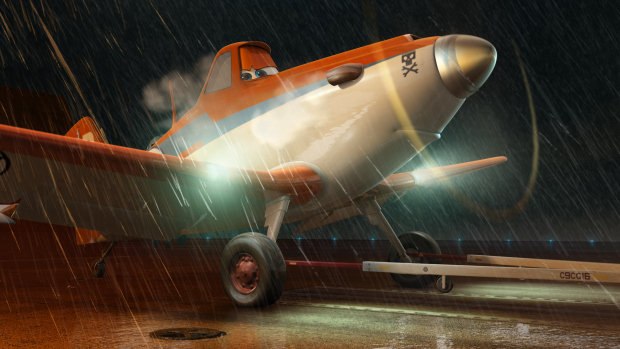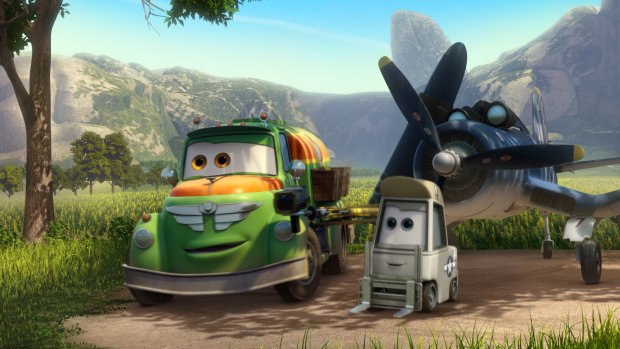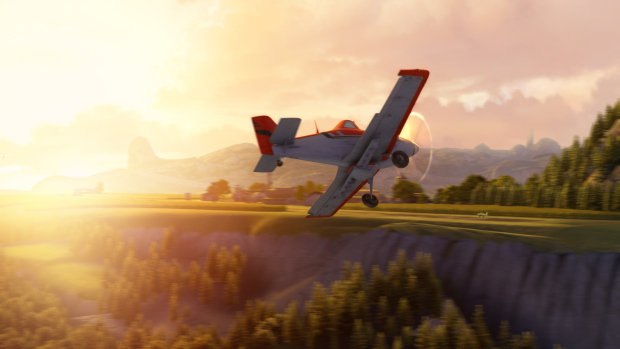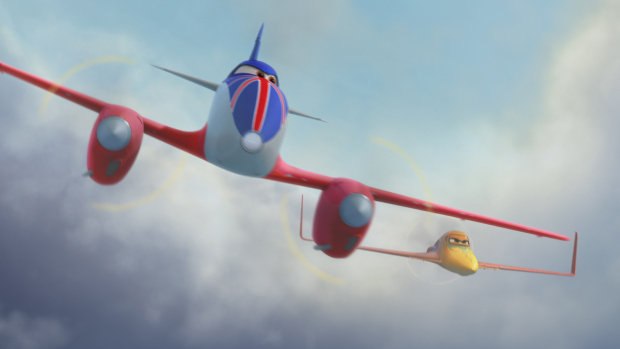Four and a half years in the making, the long-time direct-to-DVD studio’s biggest feature finally lands in U.S. theatres.
Read AWN's interview with Klay's production partner on Planes, Traci Balthazor-Flynn.
Many in the animation community breathed a welcome sigh of relief back in 2007 after hearing the announcement of big changes being made at DisneyToon Studios. Under the growing influence and creative leadership of John Lasseter, the studio canceled production plans on direct-to-DVD sequels of popular Disney and Pixar animated features. The studio began shifting towards production of original stories, moving away from a strategy that while profitable, was both creatively and philosophically unpopular.
Six years later, the studio’s biggest production to date, Planes, hits US theatres tomorrow, itself the benefit of a strategic decision to bypass a direct-to-DVD release and head straight to theatres. Set in the world above Cars, the film is billed as an action-packed comedy adventure about a crop duster with dreams of competing as a high-flying air racer, whose courage is put to the test as he aims to reach heights he never dreamed possible. “Lofty” goals indeed. I recently had a chance to sit with director Klay Hall, a CalArts alum who spent years working on beloved animated TV series like The Simpsons and King of the Hill before coming to DisneyToon Studios in 2005. He shared his thoughts about aviation, the challenges of turning planes in believable characters and how DTS fits within the Disney animated feature film studio umbrella.
Dan Sarto: So tell me about the genesis of the film?
Klay Hall: In late 2008 or early 2009, I was finishing my previous film. I had already had lots of conversations with John Lasseter. We hit it off right away because we were both fans of machines. We love Formula One racing, we love cars, we love trains and we love planes. Our conversations were always about some of the coolest things out there flying or driving. We are also history buffs. So we had a lot of common interests. Anyways, I was working on a train idea that dealt with the Transcontinental Railroad. It had steam trains, it had humans and it had animals. He really liked it a lot and was helping me flush it out.
Then one day he was flying in from Pixar and I got a call. He said, “Hey Klay, I have this idea. What do you think about planes instead of trains?” I was like, “John, if there is one thing I like more than trains, it’s definitely planes.” He laughed. Through our conversations, he knew that I had an aviation background. He was aware that my dad was a pilot in the navy. His dad was in the navy. So we shared some common ground. He knew that I had a love of flying and aviation. He said, “Look, I’m thinking about this idea. What do you think about let’s drop the trains thing for now and let’s do planes. Let’s make a whole new world above the world of Cars, drafting off the cars world that has already been established. Let’s leave it there and go for something brand new.” And that’s kind of how it all came about.
DS: So how did it get from an idea discussed with John into full feature development?
KH: It’s very much the same process they use at Pixar or Walt Disney Animation Studios. He implemented the same thing at DTS [DisneyToon Studios] too. All three studios to him, believe it or not, when we’re talking creative, it’s all the same to him. He incorporated a brain trust in our studio, just like he has in the other two studios. No executives are in the room. It’s all creative, directors, writers and some heads of stories, people like that. So once we knew we were going to go for this planes idea, myself, John and Jeff Howard, the writer, we sat down in a room for about five or six hours and kicked around ideas, things that we liked, about airplanes and about aviation.
I’m a huge fan of the classic underdog story. I think it plays universally and I think we can all relate to it. Then we came with the idea of fear. If you are able to rise above your fear for just a moment, if you’re able to step out of that zone, and go for it, you’ll be surprised with the results. We all felt that resonated universally as well. Then we landed on the crop duster because it was a plane that does the same thing every day. It’s built for one thing. So it was perfect to have that character uncomfortable with stepping out of the zone. Crop dusters cannot fly over a 1000 feet. By FAA rules they are regulated to fly under that ceiling. So it played right into the fear of heights thing…the irony of an airplane that’sscared to go high. From there we came up with the rest of the story. We knew we wanted to give him the goal of breaking this mundane routine and then just going for it. So we threw in the international race. We really wanted to embrace different locations, different ethnicities and cultures.
DS: Tell us about the decision to release Planes in theatres rather than going direct to DVD, which was the original plan.
KH: To be perfectly honest, it’s come up a lot. We didn’t have to change a thing. The crew was in place. The locations, everything was as it was. You know, at DTS, we’re a division of the Walt Disney Company. There’s Pixar, there’s Walt Disney Animation, and there’s us. John Lasseter came in and changed the whole thing that’s going on there now. It’s all about series based stories, original stories, high quality stories. We were swinging from the fences from day one, and we really didn’t have to change anything. So it was pretty amazing. The great part is, it just gives that much more legitimacy to our division and what we’re doing. People can really say, “Hey, you know what? Yeah, they’re doing good work.”
DS:The strategic move from DVD to theatrical, what does this mean with regards to future efforts by DTS?
KH: I would say that it all comes down to quality, especially with John Lasseter leading the charge. If the film is of high quality, then it has a shot of going theatrical. And I think that’s how it’s judged, and nothing more than that. You know, there are no guarantees anywhere.
DS:The flip side of that is your efforts and the film itself will be judged differently based on a theatrical release as opposed to a DVD release. Did that play a part at all in your thinking with regards to how you made this film?
KH: It gave me the opportunity to think bigger in scope. A lot of times I would think compositionally, this is going more artistic. You know, it’s not gonna be on the TV. It’s gonna be on a 50-foot screen. So it plays into the world that way, where you might not have an opportunity to think as big, as far as your palette and things like that, because you might be limited. But overall, it doesn’t change that much. If you look back at where this film was four years ago compared to where it is right now, you’re not gonna see a big difference.
DS: What would you say were the biggest production challenges on this project?
KH: Well, first of all, it’s drafting off of the Cars world, the ten years that had been spent on Cars and Cars 2, sort of being aware of that, then putting it aside and not using any of that. I mean we could draft off their knowledge on movement, personality and things like that but we were dealing with a whole new world, with a whole bunch of new characters. We definitely wanted to embrace the look of the film as far as the art direction, the charm of the characters. But one of John’s directives was, “You know, this is an opportunity to go beyond the world of Cars.” So that’s what we did. We literally are above the world of Cars.
We were dealing with airplanes. So you can imagine, we’ve got wings in the way, we have narrow canopies for our eye shapes, we have our mouths underneath, we have nose cones with propellers that are right in the way of eye lines. When you are dealing with a car, I’m not saying it’s easier but you’ve got a big windshield, you got big grills, they’re on the ground. For us, there were tons of challenges staging two or three characters together to make them believable. A lot of our planes are tail drivers. You can see how the front end is raised up so the eyes are going to be back. It’s constantly working with creative challenges like that, which are completely different than working with cars. So that was a big one right upfront.
Another huge challenge that took us a long time to crack the code on was the flight dynamics. We had Jason McKinley [who worked on Red Tails and produced and directed the Dogfights series for the History Channel] who created Dogfights, who had worked a lot in the CG world of flying. And we brought in Sean Bautista, who was a 20 year Air Force pilot and flies 747s for a living. The result was a better understanding of the inertia and the weight of the aircraft, the speed of aircraft and how they move through the air to make it believable. It took a long time and a lot of guys to be able to do that.
DS: Did you use any simulation software?
KH: We didn’t use any simulation software. It was all figured out and built on the spot. We came up with the Dusty model, the proper airframe with the right type of engine, the weight of that engine with that aircraft, what type of gas tank he would have, the amount and weight of the fuel and how that affected the aircraft. We had all the ailerons, their flaps and the rudders all correctly positioned. Then we had to build enough set where we could actually fly him in real space to see if it would work believably. When we finally cracked that code, where he was doing this Figure 8, we were like, “Wow, it looks real!” We knew we had it. Then we applied it to every other airplane, though of course the formula changed based on the size of the airplane and the engine.
DS: How does feature film directing differ from your work on TV? Which skills learned working in TV have served you best in the feature film world?
KH: When you’re working in TV you’re moving much faster. You have to be pretty clear in your thoughts and confident about your choices because you’re moving so fast. I had gained confidence working in that world as far as I could look at something and make a decision and for the most part, be sure to stick with it because I was sure on the outcome. Whereas, in feature animation, you can explore more because you have a lot more time to be able to try certain things. So that’s a big difference right there. Working in TV, you have to make quicker decisions and you have to be more confident in your choices. Having more time can certainly give you more opportunity to explore character, flush things out and try things maybe several more times. But I will say I’ve seen that a lot of times your gut, what you go with first, tends to be closer to where the scene ends up, then all this other business.
I think that’s what served me the best. I was sure about my choices upfront, and it gave me a level of confidence. When you have that you develop the trust of your crew. And hopefully you’re right in your choices. Working in features, especially with John, gave me an opportunity to go deep into the characters. I don't think you’re able to go as deep in TV.
DS: Last question. How does Walt Disney Feature Animation, Pixar and DTS fit together from your perspective and within the broader strategy of animated feature production within Disney?
KH: Here is what I hope and I think will happen. I think there is room for all of us. Coming into it, this is a cool opportunity for DTS to show what we’re capable of doing. We haven’t changed, the making of this movie has been the same from day one. It’s not like all of a sudden when we got the nod to go theatrical, we brought in a whole bunch of people and changed things. It was always this movie, always. So I think the quality of films coming out under the guidance of John Lasseter and the team of directors we have there is going to be at and beyond this level. There is room for all of us, so I hope that in the future DTS is able to release along with feature and Pixar. You know with John, it’s all about the quality of the movie, not about where it’s released. He really believes that, and that’s the pulpit that he’s pounding on. It’s up to us as filmmakers and the group of individuals at those studios to hit that level of expectation. Then, wherever the chips fall, they fall.
--
Dan Sarto is editor-in-chief and publisher of Animation World Network.
Dan Sarto is Publisher and Editor-in-Chief of Animation World Network.














